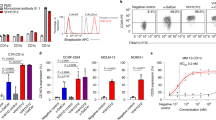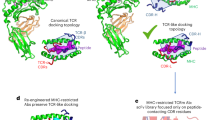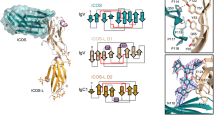Abstract
This study describes the use of the CD8/major histocompatibility complex (MHC) class I crystal structure as a template for the de novo design of low-molecular-weight surface mimetics. The analogs were designed from a local surface region on the CD8 α-chain directly adjacent to the bound MHC class I, to block the protein associations in the T-cell activation cluster that occur upon stimulation of the cytotoxic T lymphocytes (CTLs). One small conformationally restrained peptide showed dose-dependent inhibition of a primary allogeneic CTL assay while having no effect on the CD4-dependent mixed lymphocyte reaction (MLR). The analog's activity could be modulated through subtle changes in its side chain composition. Administration of the analog prevented CD8-dependent clearance of a murine retrovirus in BALB/c mice. In C57BL/6 mice challenged with the same retrovirus, the analog selectively inhibited the antiviral CTL responses without affecting the ability of the CTLs to generate robust allogeneic responses.
This is a preview of subscription content, access via your institution
Access options
Subscribe to this journal
Receive 12 print issues and online access
$209.00 per year
only $17.42 per issue
Buy this article
- Purchase on Springer Link
- Instant access to full article PDF
Prices may be subject to local taxes which are calculated during checkout





Similar content being viewed by others
References
Hehmke, B., Michaelis, D., Gens, E., Laube, F. & Kohnert, K.D. Aberrant activation of CD8+ T-cell and CD8+ T-cell subsets in patients with newly diagnosed IDDM. Diabetes 44, 1414–1419 (1995).
Peakman, M., Leslie, R.D., Alviggi, L., Hawa, M. & Vergani, D. Persistent activation of CD8+ T cells characterizes prediabetic twins. Diabetes Care 19, 1177–1184 (1996).
Yoneda, R. et al. CD8 cytotoxic T-cell clone rapidly transfers autoimmune diabetes in very young NOD and MHC class I-compatible scid mice. Diabetologia 40, 1044–1052 (1997).
DiLorenzo, T.P. et al. Major histocompatibility complex class I-restricted T cells are required for all but the end stages of diabetes development in nonobese diabetic mice and use a prevalent T-cell receptor alpha chain gene rearrangement. Proc. Natl. Acad. Sci. USA 95, 12538–12543 (1998).
Rabinovitch, A. & Suarez-Pinzon, W.L. Cytokines and their roles in pancreatic islet beta-cell destruction and insulin-dependent diabetes mellitus. Biochem. Pharmacol. 55, 1139–1149 (1998).
Wong, F.S. & Janeway, C.A. Jr., The role of CD4 vs. CD8 T cells in IDDM. J. Autoimmun. 13, 290–295 (1999).
He, G. et al. Differential effect of an anti-CD8 monoclonal antibody on rejection of murine intestine and cardiac allografts. Transplant. Proc. 31, 1239–1241 (1999).
Fowler, D.H. & Gress, R.E. CD8+ T cells of Tc2 phenotype mediate a GVL effect and prevent marrow rejection. Vox Sang 74 Suppl. 2, 331–340 (1998).
Beyers, A.D., Spruyt, L.L. & Williams, A.F. Molecular associations between the T-lymphocyte antigen receptor complex and the surface antigens CD2, CD4, or CD8 and CD5. Proc. Natl. Acad. Sci. USA 89, 2945–2949 (1992).
Wheeler, C.J., Chen, J.Y., Potter, T.A. & Parnes, J.R. Mechanisms of CD8 beta-mediated T cell response enhancement: interaction with MHC class I/beta2-microglobulin and functional coupling to TCR/CD3. J. Immunol. 160, 4199–4207 (1998).
Kwan Lim, G.E., McNeill, L., Whitley, K., Becker, D.L. & Zamoyska, R. Co-capping studies reveal CD8/TCR interactions after capping CD8 beta polypeptides and intracellular associations of CD8 with p56(lck). Eur. J. Immunol. 28, 745–754 (1998).
Janeway, C.A. Jr., The T cell receptor as a multicomponent signalling machine: CD4/CD8 coreceptors and CD45 in T cell activation. Annu. Rev. Immunol. 10, 645–674 (1992).
Parnes, J.R. Molecular biology and function of CD4 and CD8. Adv. Immunol. 44, 265–311 (1989).
Gao, G.F. et al. Crystal structure of the complex between human CD8 alpha(alpha) and HLA-A2. Nature 387, 630–634 (1997).
Kern, P.S. et al. Structural basis of CD8 coreceptor function revealed by crystallographic analysis of a murine CD8 alphaalpha ectodomain fragment in complex with H-2Kb. Immunity 9, 519–530 (1998).
Boriack-Sjodin, P.A., Margarit, S.M., Bar-Sagi, D. & Kuriyan, J. The structural basis of the activation of Ras by Sos (see comments). Nature 394, 337–343 (1998).
de Vos, A.M., Ultsch M. & Kossiakoff A.A. Human growth hormone and extracellular domain of its receptor: crystal structure of the complex. Science 255(5042), 306–312 (1992).
Banner, D.W. et al. Crystal structure of the soluble human 55 kd TNF receptor–human TNF beta complex: implications for TNF receptor activation. Cell 73, 431–445 (1993).
Kwong, P.D. et al. Structure of an HIV gp120 envelope glycoprotein in complex with the CD4 receptor and a neutralizing human antibody (see comments). Nature 393, 648–659 (1998).
Rittinger, K., Walker, P.A., Eccleston, J.F., Smerdon, S.J. & Gamblin, S.J. Structure at 1.65 Å of RhoA and its GTPase-activating protein in complex with a transition-state analogue (see comments). Nature 389, 758–762 (1997).
Cheng, Y.K. & Rossky, P.J. Surface topography dependence of biomolecular hydrophobic hydration. Nature 392, 696–699 (1998).
Pardanani, A., Gambacurta, A., Ascoli, F. & Royer, W.E. Jr., Mutational destabilization of the critical interface water cluster in Scapharca dimeric hemoglobin: structural basis for altered allosteric activity. J. Mol. Biol. 284, 729–739 (1998).
Leahy, D.J., Axel, R. & Hendrickson, W.A. Crystal structure of a soluble form of the human T cell coreceptor CD8 at 2.6 A resolution. Cell 68, 1145–1162 (1992).
Avidan, N., Sieck, T.G. & Blank, K.J. Role of T-cell subsets in acute and persistent E-55+ murine leukemia virus infection in susceptible progressor and resistant long-term nonprogressor mouse strains. Women and Infants Transmission Study. Clin. Immunol. Immunopathol. 85, 282–288 (1997).
Panoutsakopoulou, V., Little, C.S., Sieck, T.G., Blankenhorn, E.P. & Blank, K.J. Differences in the immune response during the acute phase of E-55+ murine leukemia virus infection in progressor BALB and long-term nonprogressor C57BL mice. J. Immunol. 161, 17–26 (1998).
Rockwell, A.L. et al. Rapid synthesis of RGD mimetics with isoxazoline scaffolds on solid phase: identification of alphavbeta3 antagonists lead compounds. Bioorg. Med. Chem. Lett. 9, 937–942 (1999).
Xue, C.B. et al. Design, synthesis, and in vitro activities of benzamide-core glycoprotein IIb/IIIa antagonists: 2,3-diaminopropionic acid derivatives as surrogates of aspartic acid. Bioorg. Med. Chem. 5, 693–705 (1997).
Jameson, B.A. Modelling in peptide design. Nature 341, 465–466 (1989).
Jameson B.A., McDonnell M., Marini J.C. & Korngold R. A rationally designed CD4-analogue inhibits experimental allergic encephalomyelitis. Nature 368, 744–746 (1994).
Matzinger, P. The JAM test. A simple assay for DNA fragmentation and cell death. J. Immunol. Methods 145, 185–192 (1991)
Author information
Authors and Affiliations
Corresponding author
Rights and permissions
About this article
Cite this article
Tretiakova, A., Little, C., Blank, K. et al. Rational design of cytotoxic T-cell inhibitors. Nat Biotechnol 18, 984–988 (2000). https://doi.org/10.1038/79487
Received:
Accepted:
Issue Date:
DOI: https://doi.org/10.1038/79487



